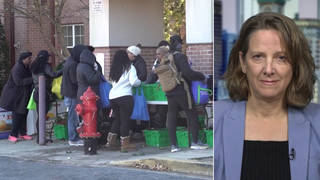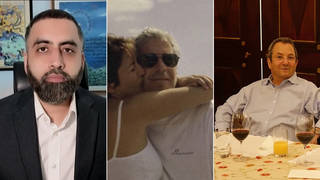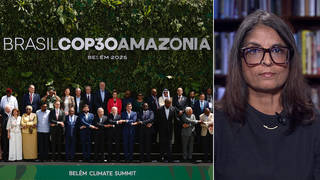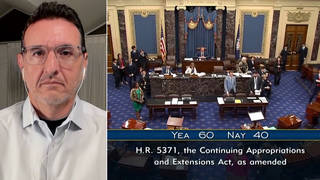
Climate justice activists — including a group of “kayaktivists” — are gathering in Portland to blockade a ship commissioned by oil giant Shell to break up Arctic ice in order to pave the way for Arctic drilling in the Chukchi Sea. Early this morning, activists with Greenpeace rappelled from the St. Johns Bridge in Portland to create an “aerial blockade” of the vessel. We speak to Annie Leonard, executive director of Greenpeace USA, as she stands under the bridge.
Transcript
AMY GOODMAN: We’re going to Portland, Oregon, where climate justice activists—including a group of “kayaktivists”—are gathering to blockade a ship commissioned by oil giant Shell to break up Arctic ice in order to pave the way for Arctic drilling in the Chukchi Sea. Early this morning, activists with Greenpeace rappelled from the St. Johns Bridge in Portland to create an aerial blockade of the vessel. Joining us on the phone now, Annie Leonard, executive director of Greenpeace USA. She is standing by the bridge.
Annie, tell us what’s happening and what your group did today.
ANNIE LEONARD: It’s an absolutely beautiful site here as the sun has come up. In the middle of the night, 13 very brave activists rappelled over the side of the bridge. They are hanging there now with ropes in between them, so they’re actually creating a human barricade. Below this, there are about 50 kayaks in the water that have a secondary line of defense. And these activists, in the air and on water, are right now the last thing that stands between Shell Oil and its absolutely pathological plans to drill for oil in the Arctic this summer.
AMY GOODMAN: Explain how they have gotten this permission and what the people of Portland are doing.
ANNIE LEONARD: Well, actually, it’s absolutely inexplicable how they have gotten this permission. I wish I could understand it myself. Shell Oil is the last oil company, besides Russia’s national Gazprom, that even wants to drill in the Arctic, because it is so extreme, so dangerous, so expensive. All the other oil companies have said it just doesn’t make sense economically, certainly doesn’t make sense environmentally or morally.
Shell has gotten almost every permit it needs to drill except one last one. And our hope today is that by delaying this ship, it gives Obama time to take action, be the climate leader he says he wants to be, and deny this last permit.
The boat that is here, as you said, is an icebreaker, and Shell’s permit requires that this icebreaker be on site. Shell left Seattle with its rig last month, got up to the Arctic. They’re under enormous times pressure, because there’s only a certain number of weeks that the region is ice-free. In 2012, when Shell went up there, it was a disaster, and they crashed, and their contractor got charged with eight felonies. And this time they have promised that they are safety-obsessed and Shell ready, yet this icebreaker, which was up in Alaska just last week, ran into something and got a 39 -inch hole in its hull. So, it is down here now getting repaired on a tight, tight timeline.
AMY GOODMAN: Annie Leonard, we have five seconds. Can President Obama do anything about this now?
ANNIE LEONARD: Absolutely, he can deny that last permit and take a stand for climate solutions. Absolutely.
AMY GOODMAN: Annie Leonard, thank you for being with us, standing by the bridge where Greenpeace activists have formed an aerial blockade. Annie Leonard, executive director of Greenpeace USA.












Media Options